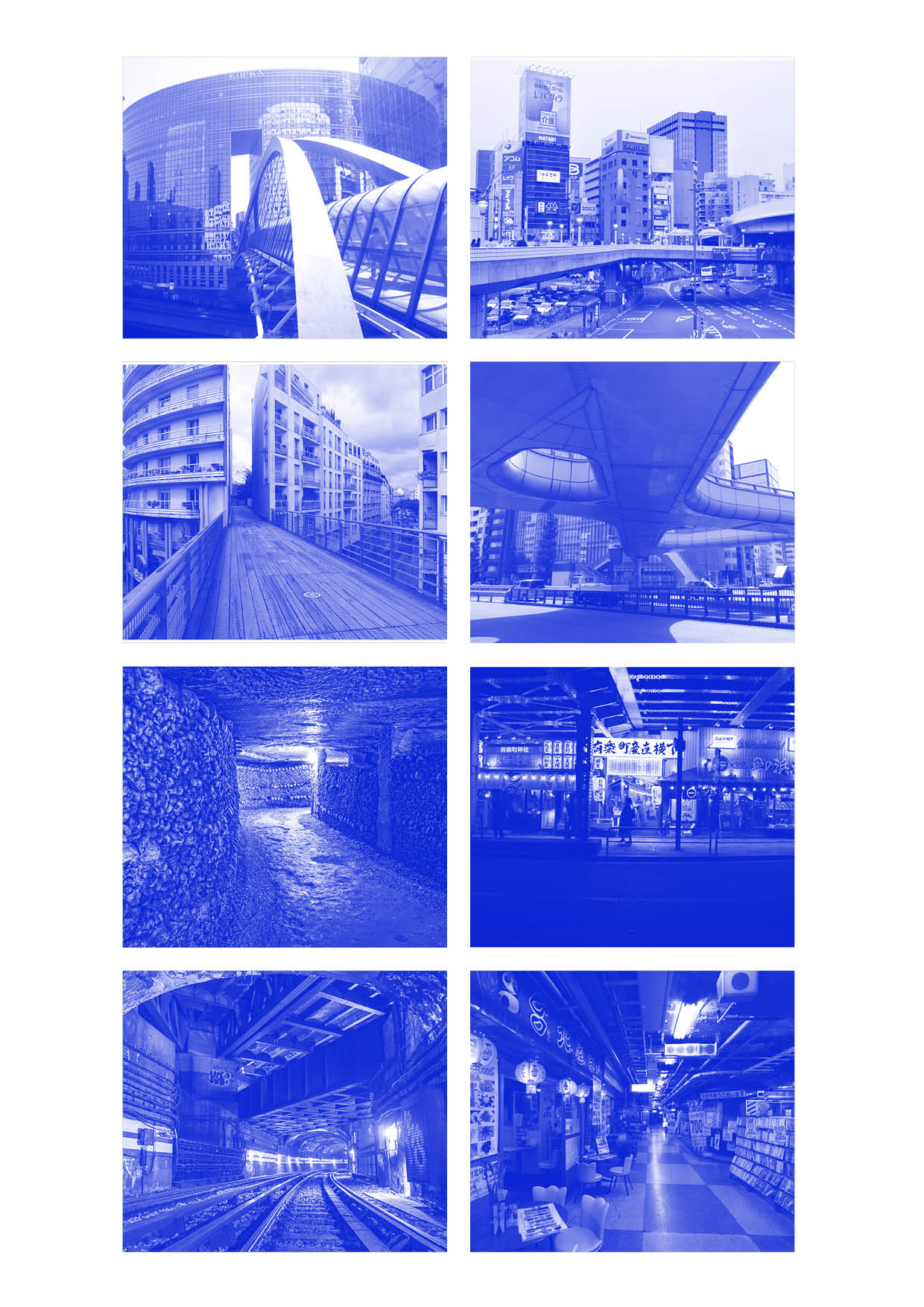
As above so below
Metropolitan, Underground, Ginza, Tokyo, Paris, Transportation, Technology
What if the solution was not to destroy the existing city, but to build around, above and below it? With this radical reasoning, certain architects design Utopic plans to renovate Paris and Tokyo’s urban landscape and city lifestyles: a floor above the city’s zinc roofs, a city below the Seine or Edo River, or even an underground highway network. The influence of this utopic way of thinking for the Metropolis is embodied today in the construction of skyways, elevated pedestrian bridges and a massive underground subway system. While the Japan Bridge in La Defense elevates to connect two skyscrapers, Asakusa underground shopping mall buries beneath the ground stores and restaurants. While the Catacombs of Paris embraces the underground space to solve a public health issue, on the third floor above Tokyo’s ground level the Metropolitan Expressway floats on top of the built fabric. Some complex buildings mix the above with below connections. In Tokyo, the T-CAT has a high-tech bridge on Metropolitan Expressway, a street on the first floor, and the first floor below ground connects to the subway Suitengu-mae Station through the underground passage1. Ueno skyway and the Showadoriginzahodo Bridge are complex overhead pedestrian walkways horizontally connecting vital parts of the metropolis and act as an extension of pedestrian circulation. Moreover, the crowded underground space of Tokyo involves streets, alleys, and urban spaces bursting with human scale and senses. Ginza’s back alleys illuminate the nightlife of Tokyo and bring back the human scale that the modern European city model ruined2.
1. Tokyo City Air Terminal, “What is T-CAT?”. Accessed March 13, 2020. http://www.tcat-hakozaki.co.jp/en/tcat/
2. Jinnai Hidenobu, Kimiko Nishimura,Tokyo: a spatial anthropology (University of California Press, 1995)
See ephemera: 26
Metropolitan, Underground, Ginza, Tokyo, Paris, Transportation, Technology
What if the solution was not to destroy the existing city, but to build around, above and below it? With this radical reasoning, certain architects design Utopic plans to renovate Paris and Tokyo’s urban landscape and city lifestyles: a floor above the city’s zinc roofs, a city below the Seine or Edo River, or even an underground highway network. The influence of this utopic way of thinking for the Metropolis is embodied today in the construction of skyways, elevated pedestrian bridges and a massive underground subway system. While the Japan Bridge in La Defense elevates to connect two skyscrapers, Asakusa underground shopping mall buries beneath the ground stores and restaurants. While the Catacombs of Paris embraces the underground space to solve a public health issue, on the third floor above Tokyo’s ground level the Metropolitan Expressway floats on top of the built fabric. Some complex buildings mix the above with below connections. In Tokyo, the T-CAT has a high-tech bridge on Metropolitan Expressway, a street on the first floor, and the first floor below ground connects to the subway Suitengu-mae Station through the underground passage1. Ueno skyway and the Showadoriginzahodo Bridge are complex overhead pedestrian walkways horizontally connecting vital parts of the metropolis and act as an extension of pedestrian circulation. Moreover, the crowded underground space of Tokyo involves streets, alleys, and urban spaces bursting with human scale and senses. Ginza’s back alleys illuminate the nightlife of Tokyo and bring back the human scale that the modern European city model ruined2.
1. Tokyo City Air Terminal, “What is T-CAT?”. Accessed March 13, 2020. http://www.tcat-hakozaki.co.jp/en/tcat/
2. Jinnai Hidenobu, Kimiko Nishimura,Tokyo: a spatial anthropology (University of California Press, 1995)
See ephemera: 26


